As a mother of two young (not yet school-age) boys with the attention spans of a gnat and an exceptional ability to make our house feel twice as small, I have serious reservations about buying them new toys. But I don’t have the same qualms when it comes to books. Our house is cluttered with children’s books and I’m constantly on the lookout for more. More recently, I’ve been on a search for books to introduce broader aspects of Korean culture to my kids than what they get from me (which is pretty minimal and primarily through food).
For those of you who might be looking to do the same, I’ve compiled a list of toddler-to-kindergartener age children’s books I found that spotlight Korean culture, the language, or speak to the Korean-American experience. These are roughly ordered from most to least recommended – based purely on my own opinions as informed by my two little guinea pigs, ages 5 and 20 months (who, because of their age difference, didn’t always see eye to eye). Hope you find this useful!
1. WHERE’S HALMONI? by Julie Kim
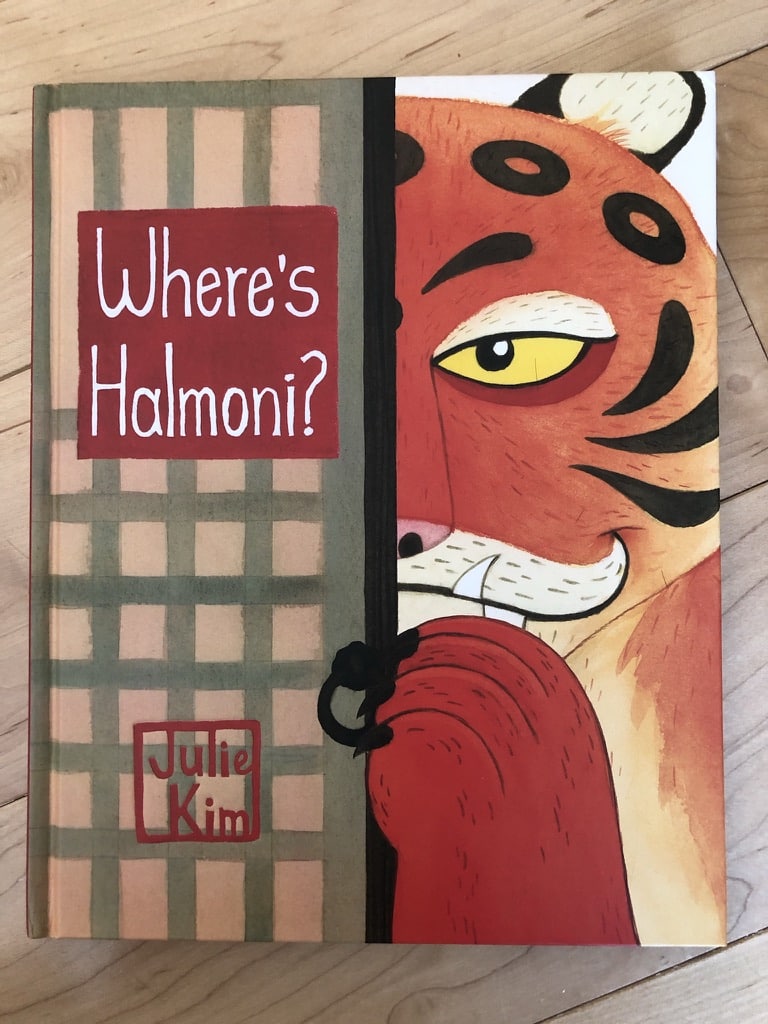
Where’s Halmoni? is more akin to a graphic novel than a traditional Korean children’s book. It follows two siblings who, while on a search for their missing grandmother (halmoni), find themselves caught in a fantasy world full of animals and creatures of Korean folklore. The tale has a clever and somewhat cryptic ending, suggesting that halmoni is more wily than her grandchildren may have thought!
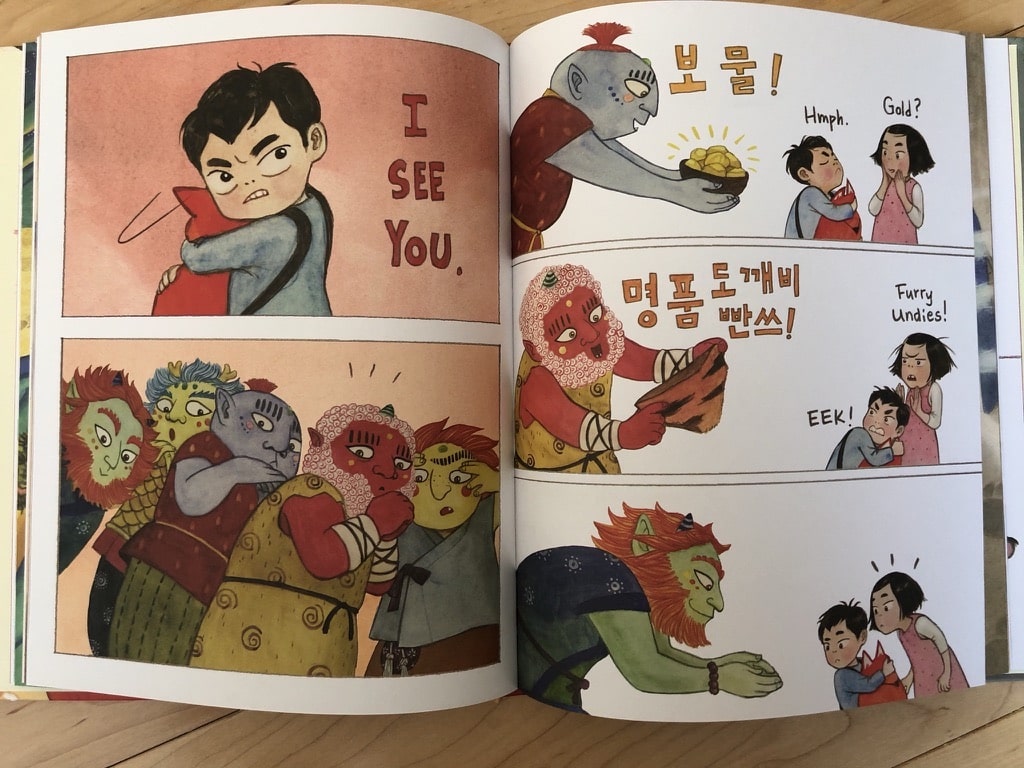
My kids enjoy this one A LOT. My 5 year old can spend almost an hour flipping through the pages of various graphic novels, so this was a welcome addition to his collection. But even my toddler goes back to this book again and again. The illustrations are engaging for all ages, and the accompanying storyline is clear and easy to follow. While written in English, some Korean is interspersed throughout the book. But it’s still completely possible to follow the storyline even if you can’t read or understand the Korean parts. (And, the author also thoughtfully translates the Korean portions at the end of the book, for anyone who really wants to know what the text says.)
This book wasn’t initially among my personal favorites, but it’s grown on me quite a bit since I first picked it up. I love that it introduces and incorporates concepts from traditional Korean folklore. But most importantly, like I said, both my children love this book. Between my husband and myself, we probably read Where’s Halmoni? to our pleading toddler at least a couple dozen times in the last week. And if a book can also engross my 5 year old such that he will flip through the pages, alone, for longer than 10 minutes, how can I argue with that? It’s an obvious win-win.
2. NO KIMCHI FOR ME! by Aram Kim
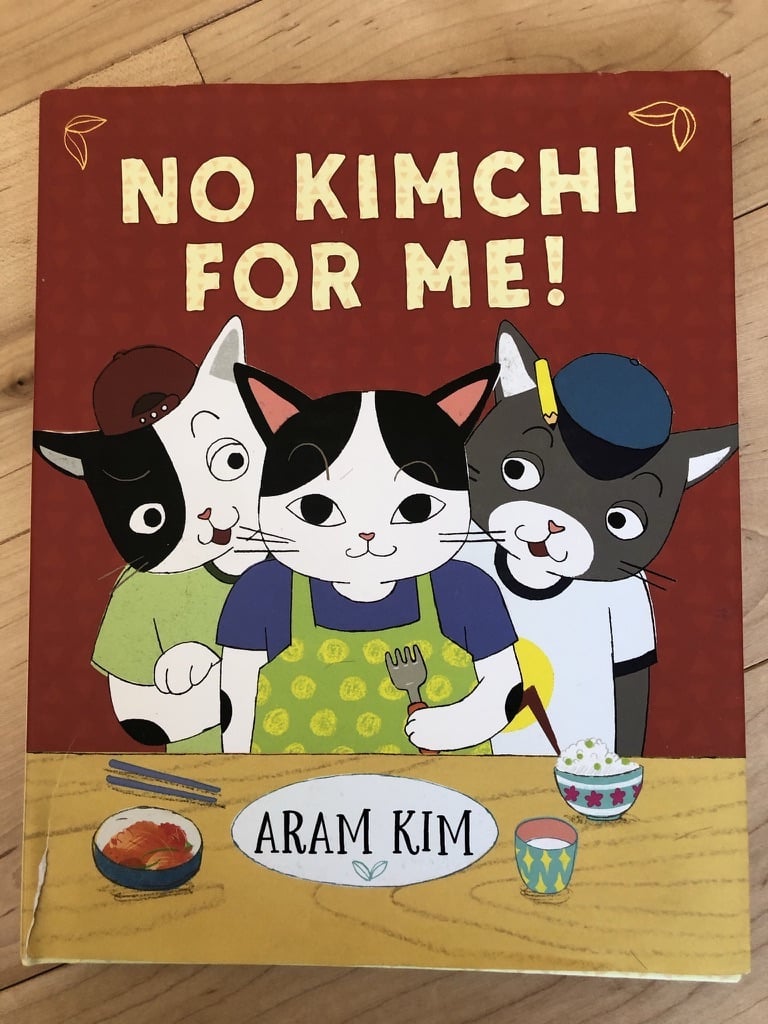
No Kimchi For Me! is a lighthearted tale about Yumi, a young cat who can’t stand the taste of kimchi and tries to find different ways to mask its taste. She tries everything from kimchi ice cream to kimchi pizza and hates it all, until her grandmother makes her kimchi pancakes (kimchijeon).
I like that the book places kimchi front and center of the story, making it more mainstream and accessible to children. For my kids, who don’t know any Korean families outside of their relatives and don’t have Korean friends, this book shows that kimchi isn’t just something weird that only they eat at home. They also know and love kimchijeon, so it was fun to see that represented in the book! And for foodies and cooks, this book also includes a recipe for kimchijeon at the end.
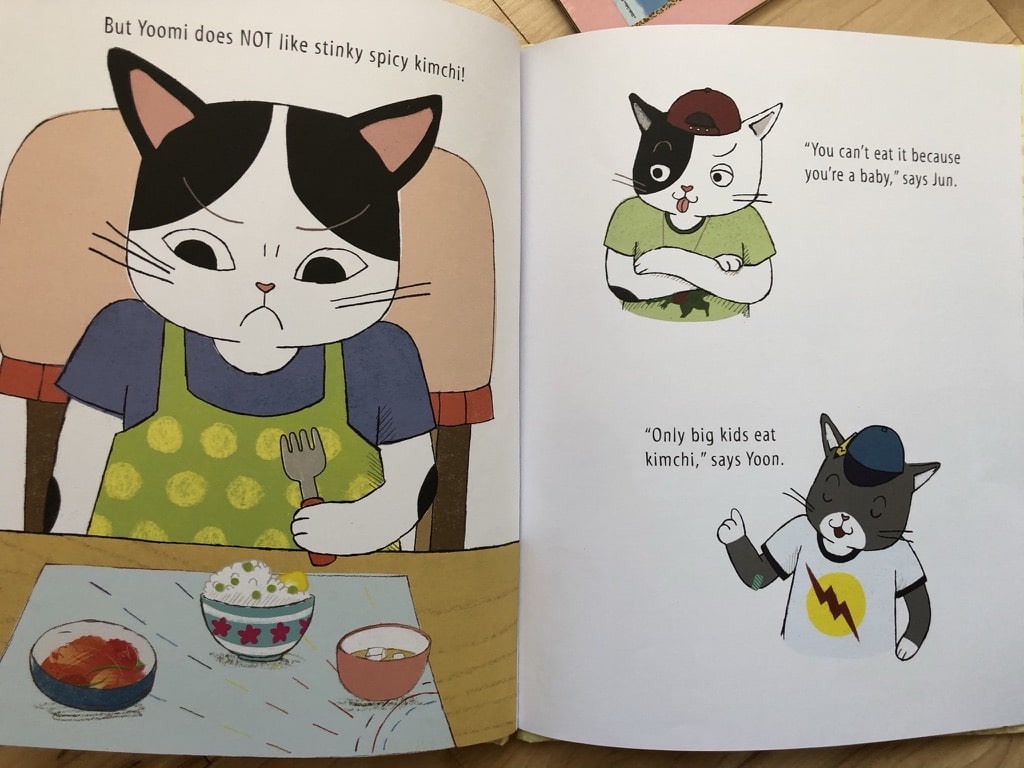
At the outset, I thought No Kimchi For Me! would be better suited for my toddler – the sentences are short and the storyline is simple. But both of my kids enjoy the playful illustrations, which are reminiscent of a comic book, and love reading about Yumi’s feline family and her travails with kimchi. It’s one of their new favorites. I don’t think it’s a coincidence that No Kimchi for Me! is also designated as a Teachers’ Pick on Amazon.
3. DANBI LEADS THE SCHOOL PARADE by Anna Kim
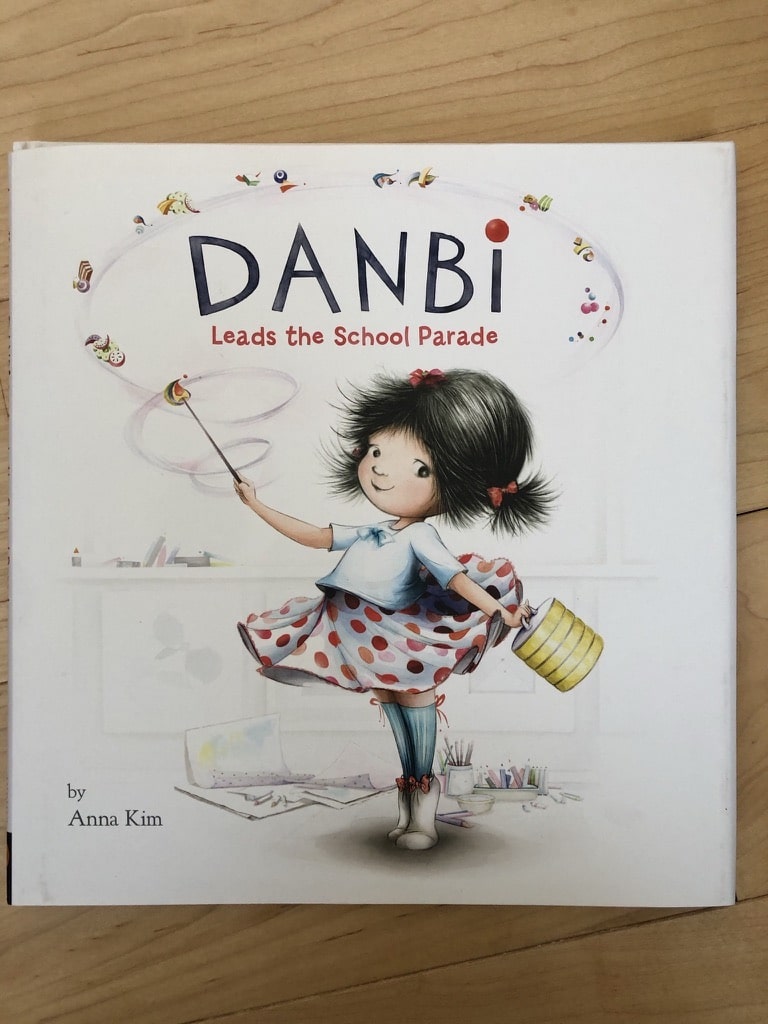
Danbi Leads The School Parade is a charming, encouraging story about a little Korean girl starting her first day of school in America. She doesn’t speak the language and initially has a hard time fitting in. But Danbi eventually finds a way to break the cultural barrier and lead her new friends in a celebration of fun!
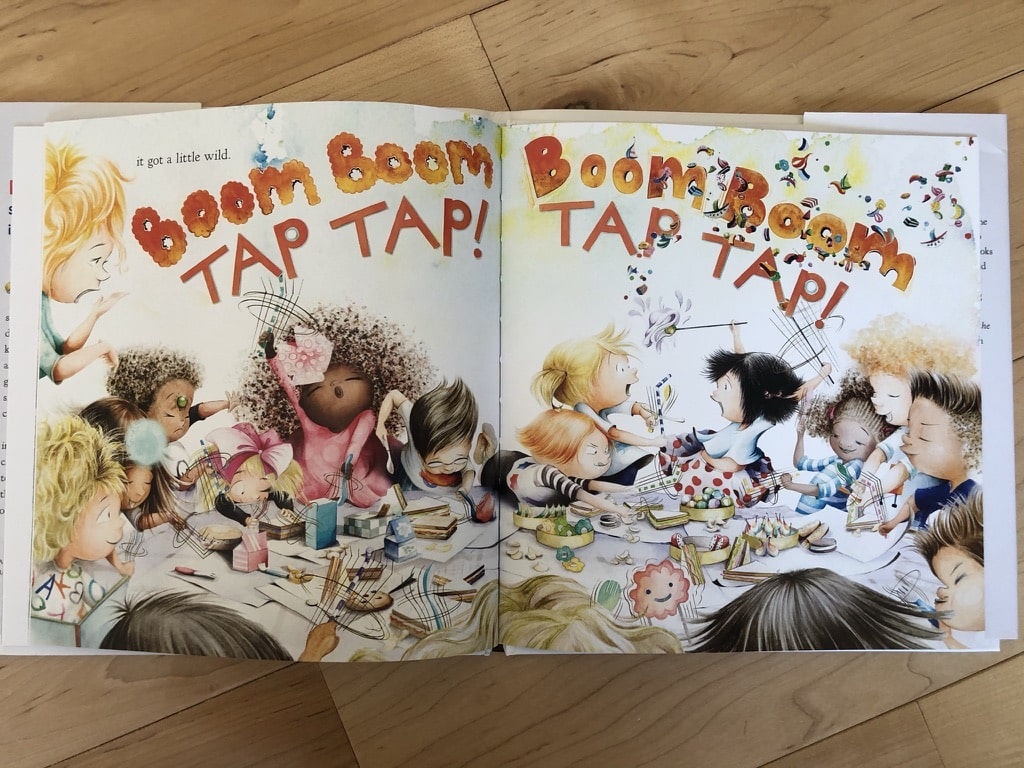
Not only is the storyline relatable for so many children (whether new to the country or simply the new kid in school!) but it’s also full of brilliant illustrations that are beautiful enough to stand on their own. The fine details and vivid colors alone capture your attention and keep you turning the pages. For that reason, I enjoy reading this book as much as my children do. It’s become part of our regular reading rotation. And I’m definitely not the only one who thinks this is a great book – Danbi Leads The School Parade has been selected as an Editor’s Pick on Amazon for the 3-5 year age group.
4. BI-BIM-BOP! by Linda Sue Park, illustrated by Ho Baek Lee

Bi-Bim-Bop! is a whimsical story told from the perspective of a hungry child waiting eagerly for her mom to finish making bibimbop (a Korean mixed rice dish with an array of vegetables and beef). It introduces the reader to how bibimbop is made while offering a glimpse into the cultural mores of a traditional Korean family.

Bi-Bim-Bop! is a fun read, ideal for toddlers. It’s told in simple rhyme and accompanied with clear, easy-to-follow pictures. It also helps that “bibimbop” apparently is a fun word for little kids to repeat. As soon as I finished reading the book to my toddler, he immediately reached for it while exclaiming, “Bim-bop! Bim-bop! Again!” I then proceeded to read it to him again… and again… and again. As an added bonus, it includes a recipe for bibimbop at the end. And it’s also teacher-approved, designated a Teacher’s Pick recommendation on Amazon.
5. WHEN SPRING COMES TO THE DMZ by Uk-Bae Lee
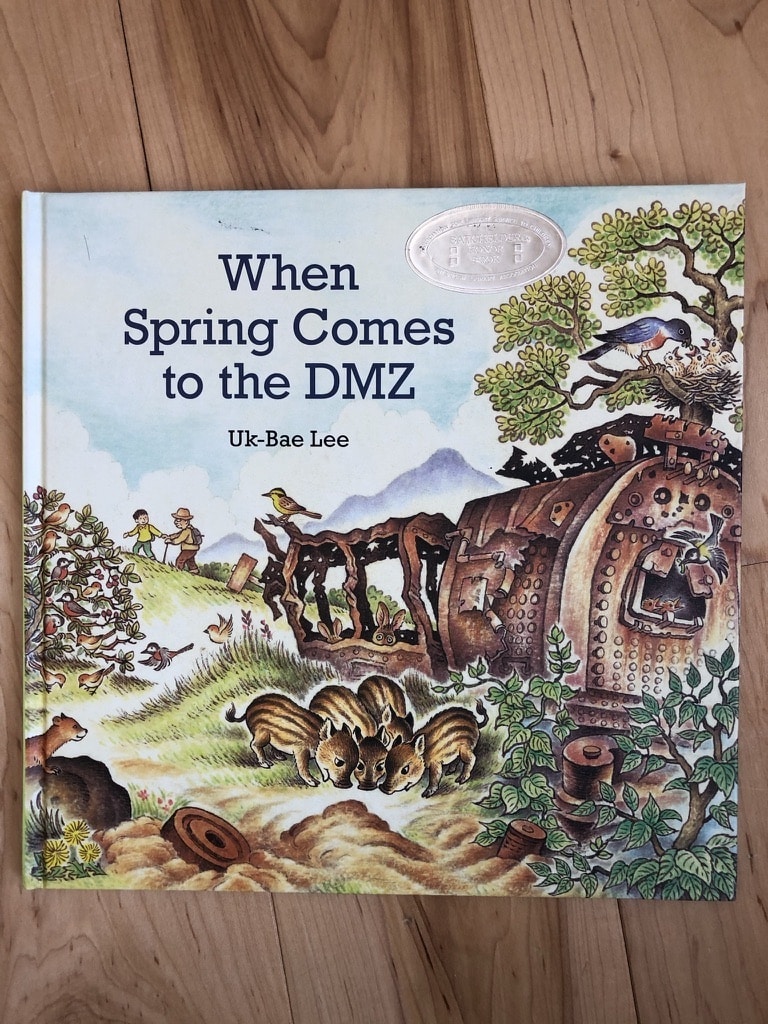
When Spring Comes to the DMZ is a beautifully told story, with lovely illustrations, that tracks the changing seasons of the DMZ and portrays wildlife native to the region. It explores Korea’s demilitarized zone from a naturalist angle seldom associated with the notorious border. But while it celebrates the DMZ’s beautiful landscape, the book also doesn’t ignore the zone’s tragic role in severing families.
The story also follows an elderly man who persistently visits the DMZ through all the passing seasons to gaze at the northern sky, at his homeland. And at the end of the book, we’re invited to dream along with the man as he flings open the fence barricading the DMZ and reunites with family. By weaving in this perspective, the book subtly protests the stark contrast between the freedom of animals to pass freely between the borders and the restrictions on people – kinsmen – from doing the same.
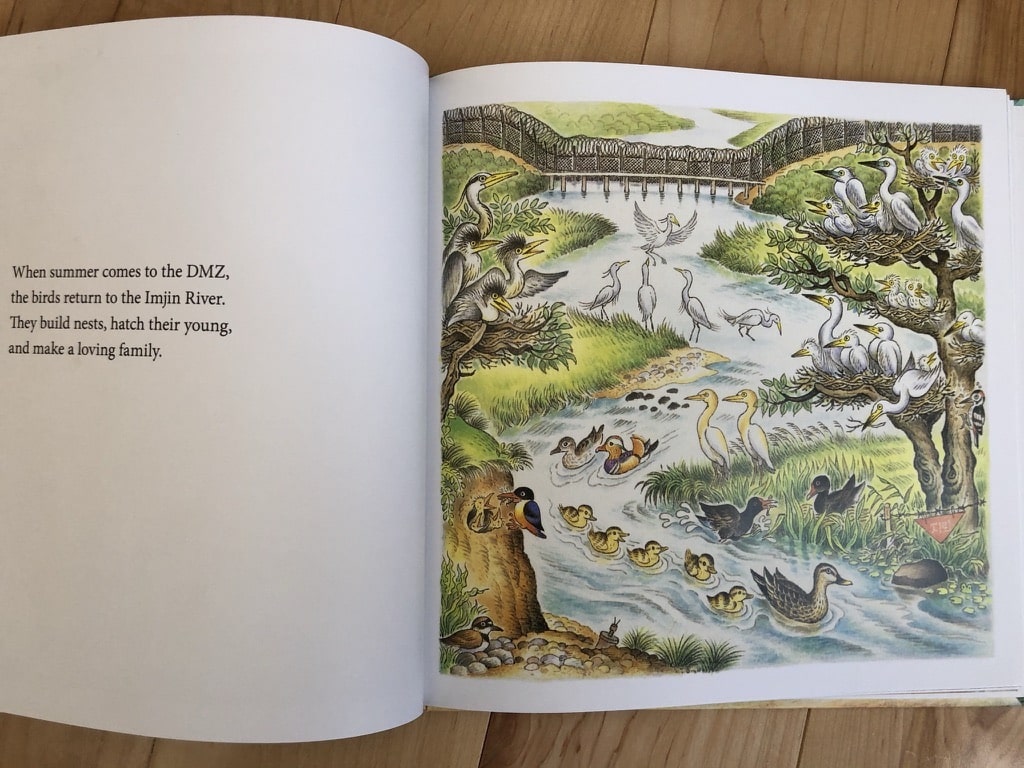
I love this book. I teared up reading it, imagining all the people – my grandparents included – who were ripped apart from their families during the Korean War and have been unable to establish contact since. The book is a great means of introducing a weighty topic to children without being either too rosy or too somber. It gives you the chance to impart, to any inquisitive child, a history lesson as well as a recognition that freedom isn’t a universal experience.
My 5 year old was naturally more interested in this book, full of questions as to why the DMZ is surrounded by barbed wire, and whether the soldiers guarding either side are “nice or mean,” and if the “good guys won the fight.” But my toddler also sits through this book very well, captivated by the large, colorful pictures of wildlife and engaged with the concise storyline. I highly recommend this book.
6. THE NAME JAR by Yangsook Choi
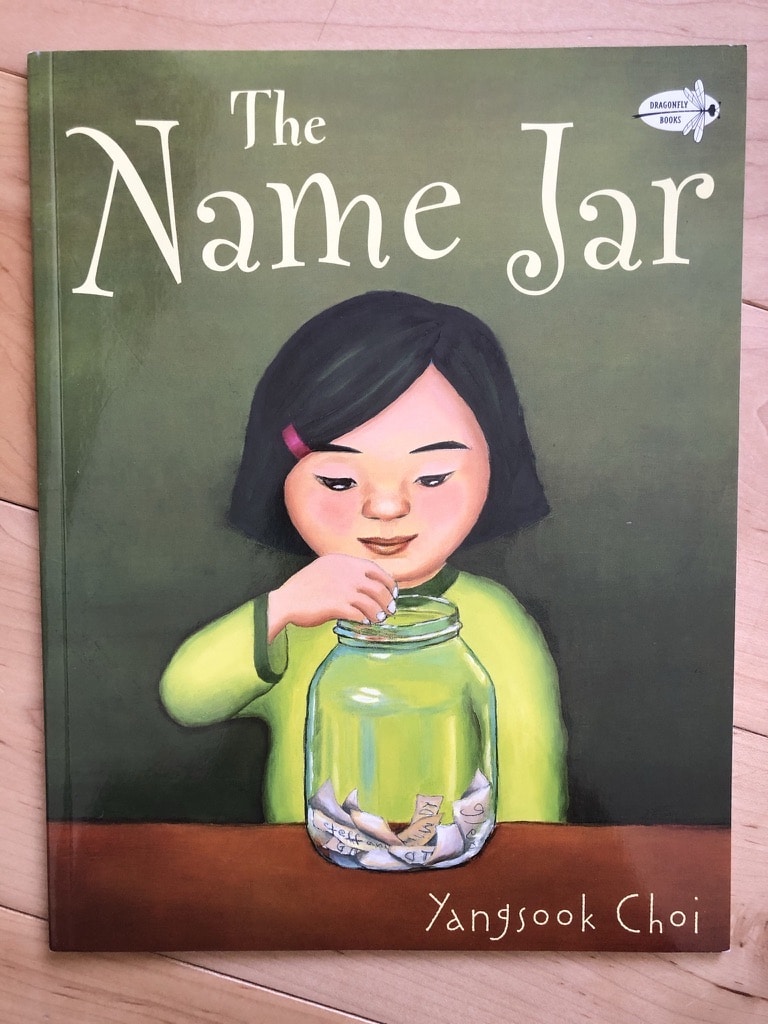
The Name Jar tells the story of Unhei, who just moved from Korea and is starting her first day of school in America. On the bus ride to school, she’s embarrassed to discover that nobody can pronounce her name. So when she’s asked to introduce herself to her new class, she hides her real name and tells them she will pick a name by the following week. Her new classmates decide to help Unhei by adding English name suggestions into a glass jar. But over the course of the week, with the unexpected help of a new friend, Unhei learns to embrace the beauty of her own name.
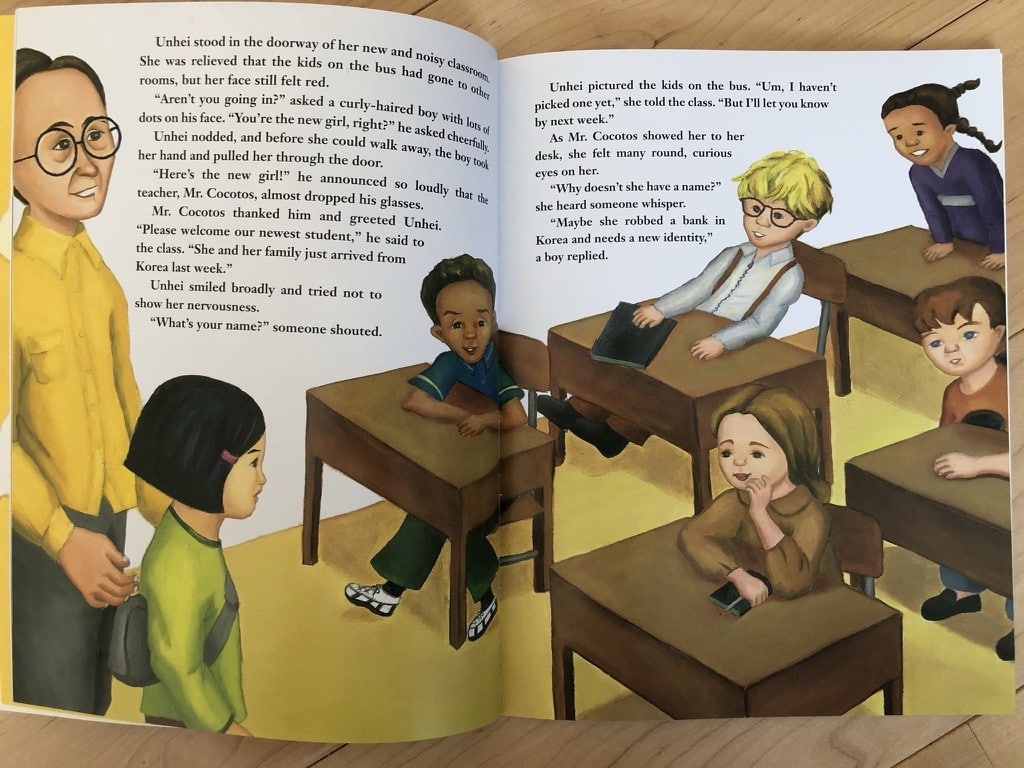
I loved the message behind this book and wish it had existed when I was a child! As someone who also grew up with a Korean name that nobody could pronounce, I could relate with the burning sense of shame every time my name was butchered in every phonetic variation imaginable. Like Unhei, though, I was also fortunate to have a few people in my life – sometimes even strangers – who encouraged me to see my name as an emblem of beautiful distinction.
The Name Jar captures this struggle common among so many immigrant communities, between assimilation and authenticity. But even if your children can’t relate to name shame (as mine can’t), The Name Jar also conveys the universal emotions of social anxiety, empathy and kindness.
While illustrated with full-page pictures, the text on each page is fairly long – so it’s perhaps better for children with longer attention spans. That said, my toddler surprisingly sat through the entire book (although I did have to speed read through several pages).
All in all, a lovely book with a kind message and a good exercise in empathy for young children. Unsurprisingly, our educators tout it too – The Name Jar is a Teacher’s Pick recommendation on Amazon.
7. 엄마 마중 (WAITING FOR MAMA) by Tae-Jun Lee and Dong-Seong Kim
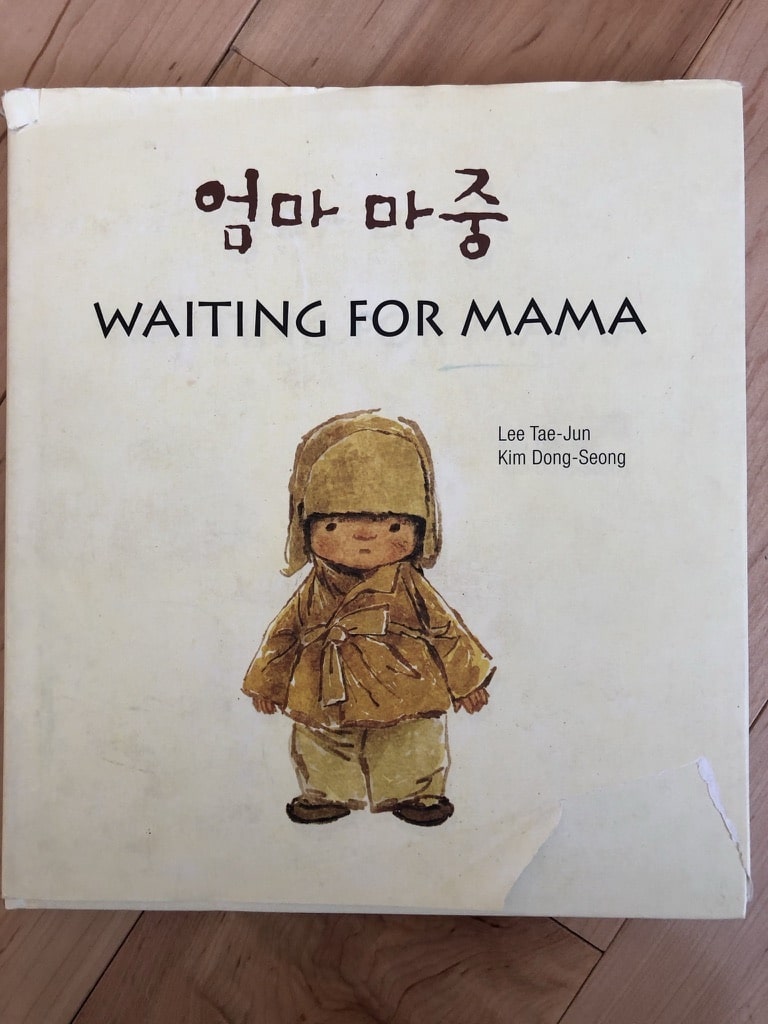
Waiting for Mama is a reprint of a simple, poignant story that was first published in a Korean newspaper in 1938. It tells the story – in both Korean and English – of a young child waiting patiently at a trolley station for his mother to return.*
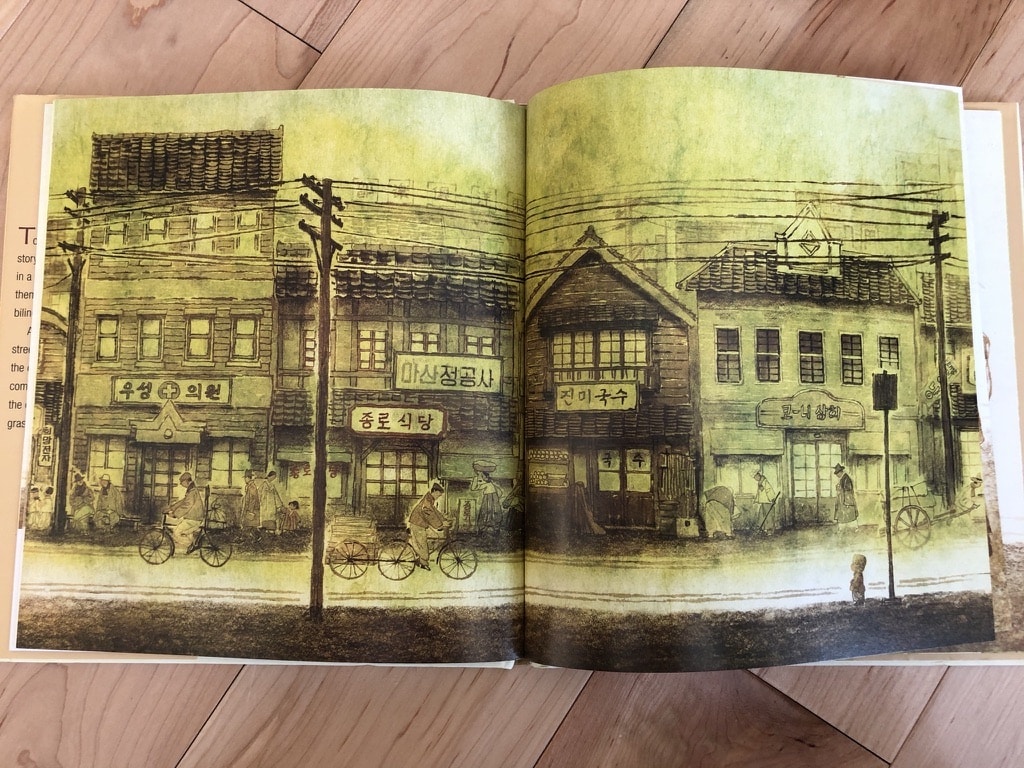
I was skeptical that my kids would like this book. Because it dates almost a century ago in the bleak days when Korea was under Japanese occupation, it’s more reminiscent of a historical memento than a children’s book. It lacks the bright, bold colors typical of most children’s books, and while the illustrations are beautiful in their simplicity I was doubtful that they would catch, much less hold, my kids’ attention. But, I was wrong. Both of my children sat through this book starting around 18 months, and still enjoy it today.
And because it’s presented in both Korean and English, it’s great for exposing your children to the Korean language. Overall, a great buy – the book wraps history, culture, and entertainment all in one, and is enjoyable for children and adults alike.
*My son was very troubled by what seemed to be an unresolved, sad ending to this book. But don’t gloss over the last page! Look closely. You’ll see that the story actually ends on a happy note.
8. THE TURTLE SHIP by Helena Ku Rhee, illustrated by Colleen Kong-Savage
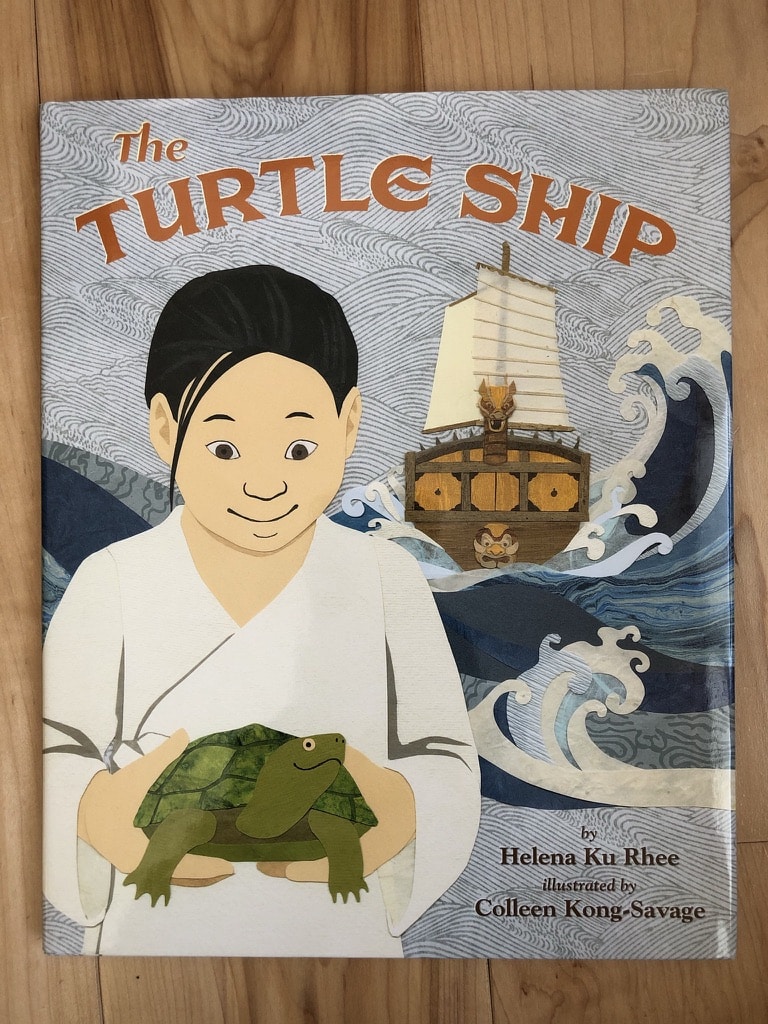
The Turtle Ship is historical fiction that explores the famed turtle warships (gubukseon) of ancient Korea. It tells the story of a young boy in 16th century Korea who, along with his pet turtle, enters a contest to come up with the best design for a warship. Inspired by the small but sturdy resilience of his pet, the boy presents the idea of building a ship to simulate a turtle with its protective, impenetrable shell and aquatic buoyancy. While initially ridiculed, the boy eventually wins the contest and goes on to become a navy admiral for the kingdom.
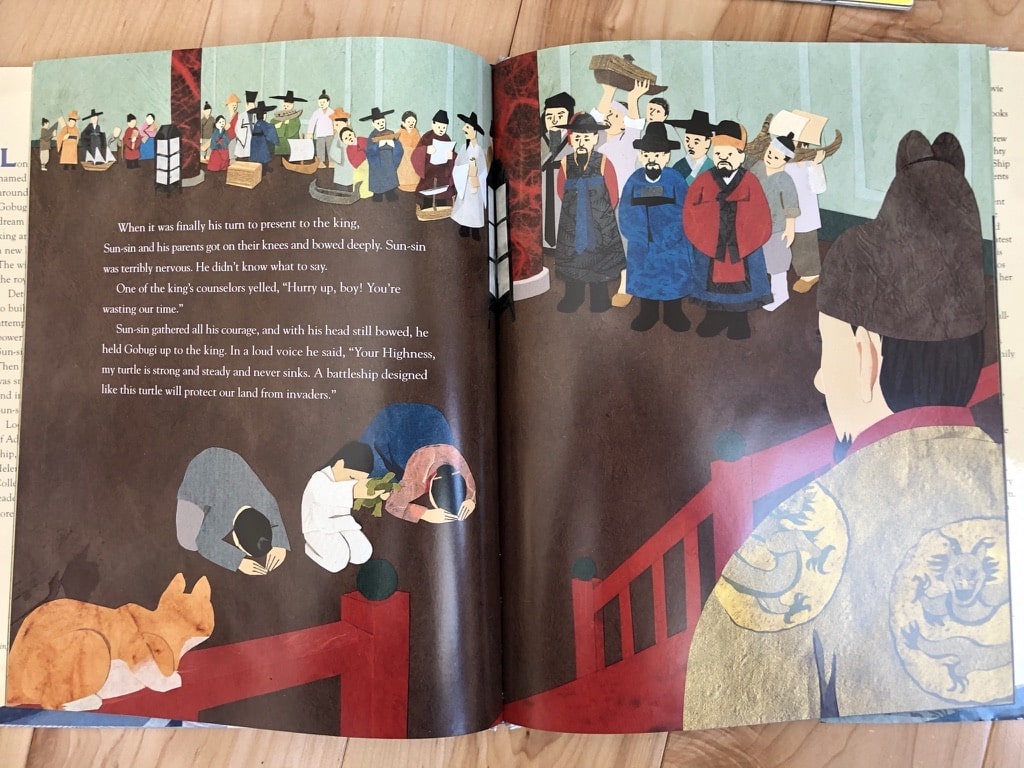
While its depictions of the turtle ship are factually accurate, the book’s plot is only loosely based on real events. The infamous turtle ships were indeed said to have been invented by one of Korea’s preeminent admirals at the time – but he didn’t come up with the design as a child, and the story takes creative license in imagining why and how the admiral was inspired by the seemingly ordinary turtle.
One of my favorite genres is historical fiction, so I personally enjoyed this book a lot. It was also a hit with my 5 year old, who loved seeing pictures of and learning about these ancient warships. The storyline on each page was a bit too long to hold my toddler’s attention, but the level of detail is perfect for my older one. Bottom line – The Turtle Ship recounts ancient history in an inviting way, making it a fun read for both adults and children.
9. THE OCEAN CALLS: A HAENYEO MERMAID STORY by Tina Cho, illustrated by Jess X. Snow
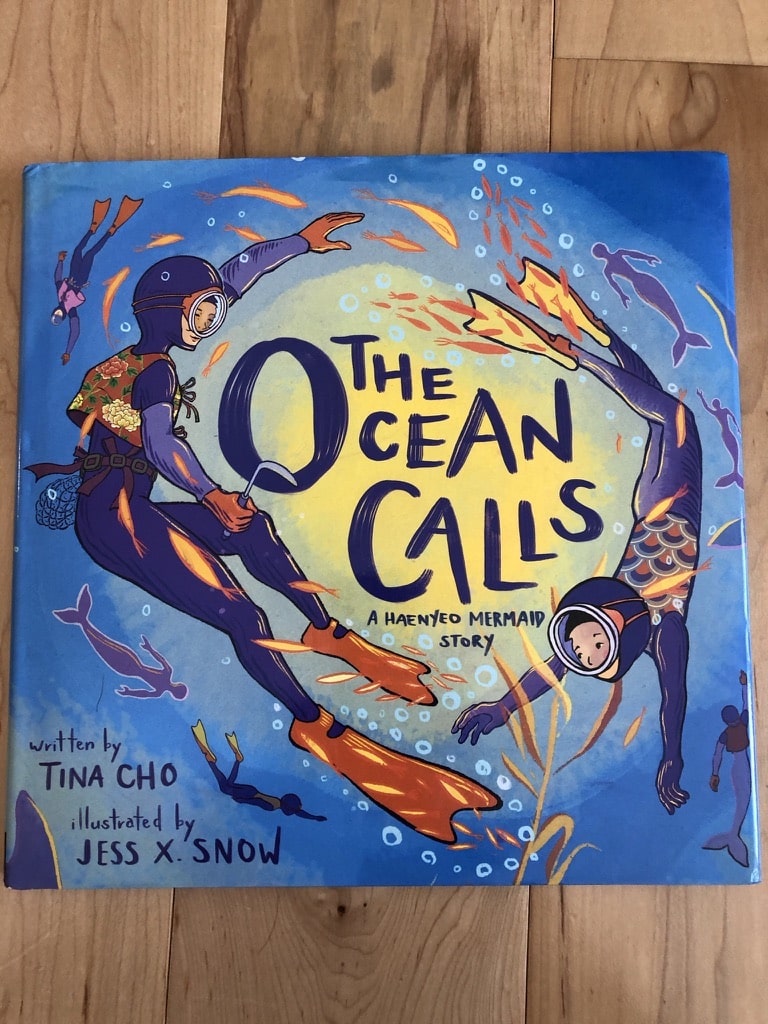
Haenyeo, literally “sea woman”, are traditional female free divers in the Korean province of Jeju who make a living harvesting sea life from the ocean. The Ocean Calls explores the relationship between a young girl and her haenyeo grandmother and, in parallel, their relationship with the sea. It tells the story of Dayeon, who wants to become a haenyeo just like her grandmother. She trains under the patient guidance of her grandmother, who teaches Dayeon to overcome her fears of the ocean and to appreciate its natural beauties.
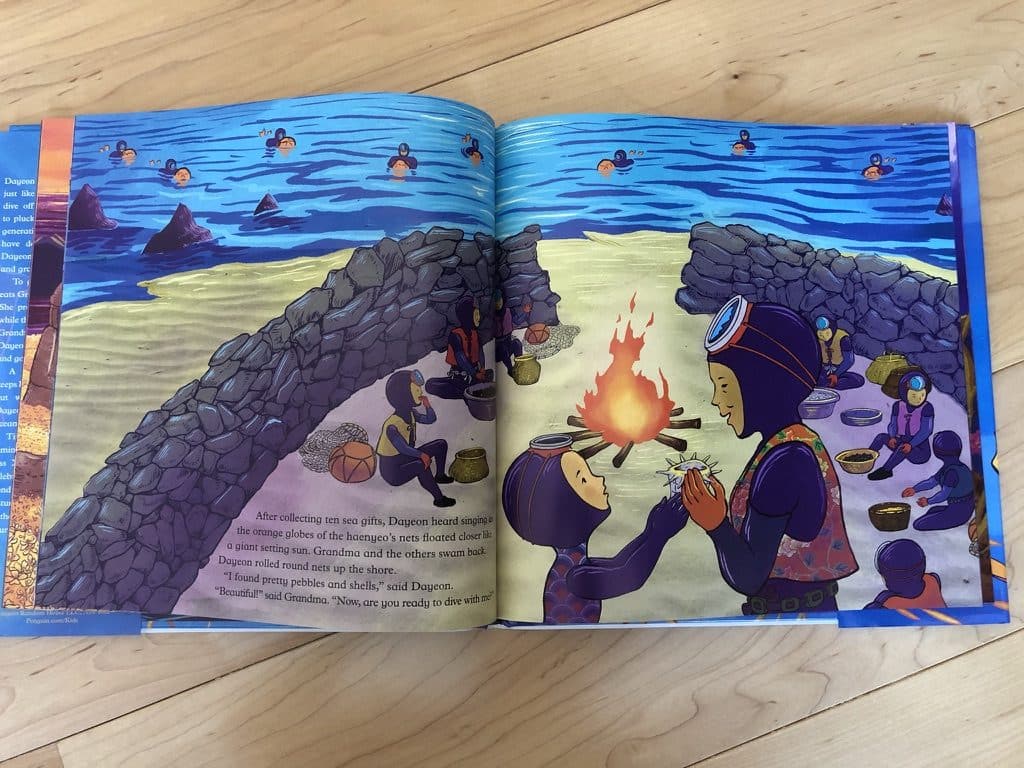
I love that this book features a centuries-old, semi-matriarchal way of life in Jeju that’s little known to most outside Korea. The Ocean Calls simultaneously illuminates the lives of haenyeo while celebrating their strength of mind and spirit.
As a parent, I also appreciated the underlying themes of persistence and perseverance woven through the story. While less interesting to my toddler, the story resonated with my 5 year old who enjoys reading about all things related to the ocean and, like Dayeon, has struggled to conquer his own underwater anxieties. Overall, a beautiful memorialization of a fading tradition, probably best suited for preschoolers to young elementary age children.
10. MY FIRST BOOK OF KOREAN WORDS by Henry J. Amen and Kyubyong Park, illustrated by Aya Padron
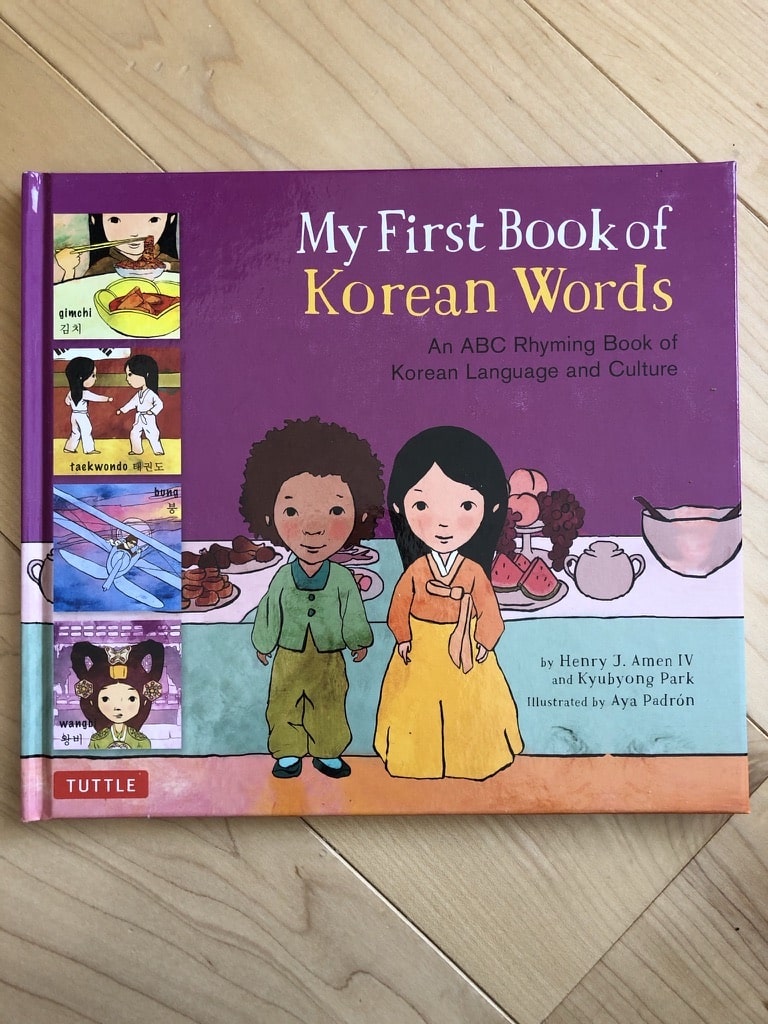
My First Book of Korean Words is like the Korean equivalent of an ABC book of rhymes. It uses the English alphabet (A, B, C…) to teach – in rhyme! – Korean words that start with the same sound (achim, bada, chukgu…). And when there is no equivalent sound in the Korean language (like “F” or “X”) the authors find clever workarounds.
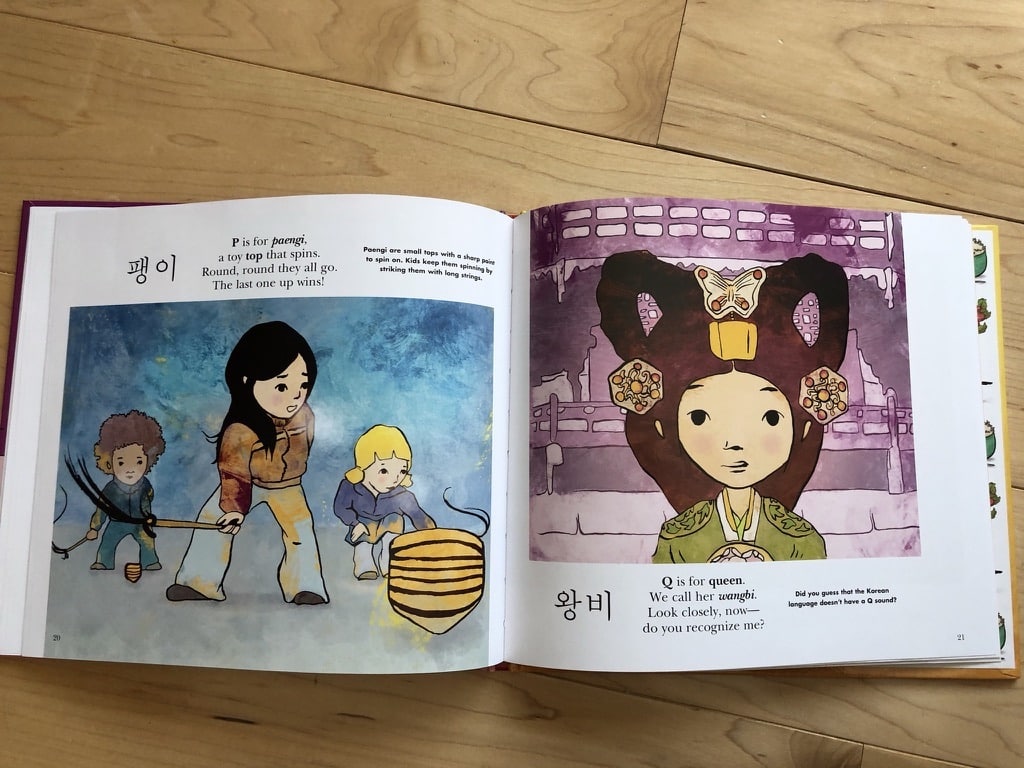
This Korean children’s book is a nice blend between instructional and entertaining – the type of book that will help my kids learn without them even realizing it. (In other words, the best kind.) Beyond the simple rhymes, the book also scatters fun linguistic and cultural facts throughout the book. For example, did you know that in Korea people say there’s a rabbit in the moon, rather than a man in the moon? The only downside is that my kids don’t show a ton of interest in reading this book. But they also don’t protest when I reach for it and will usually sit through until the end. So I still think it’s worth it – I’d buy it again.
11. 뽀로로 에듀 사운드북(PORORO EDUCATION SOUND BOOK) by Kidsicon
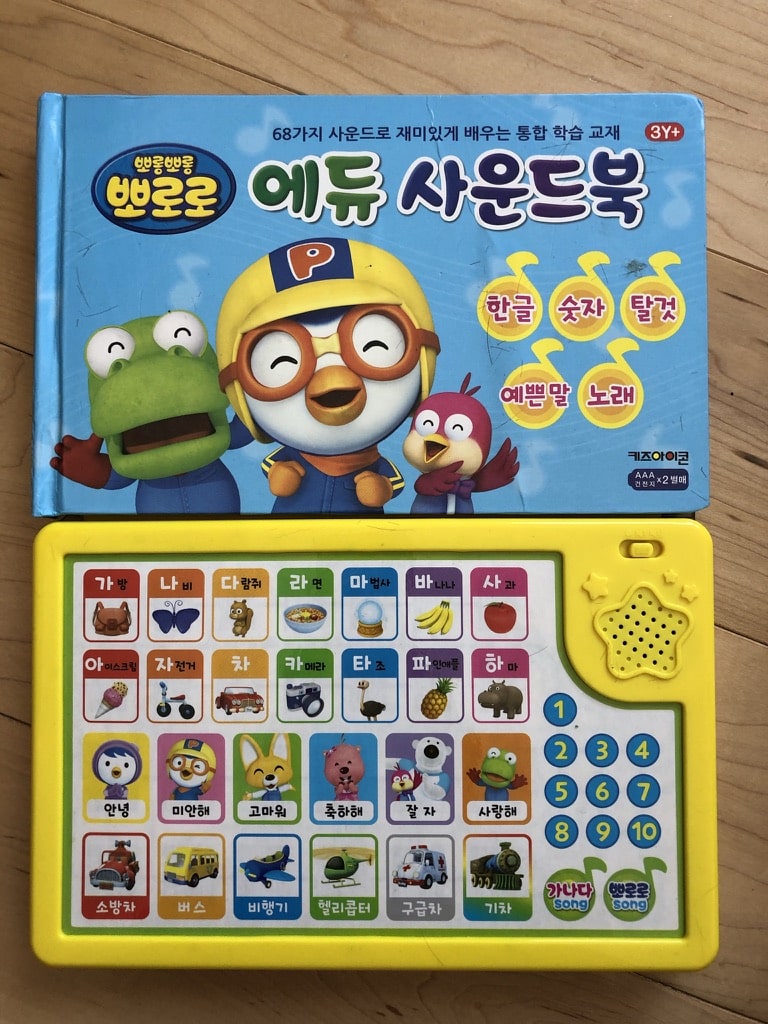
The Pororo Sound Book is an educational book geared towards teaching kids the Korean alphabet (hangul) as well as several common expressions and words.The best thing about this book is also the worst – it’s a sound board book. With great battery life.
It plays an incredibly catchy (or extremely annoying, depending on the moment) rendition of a Korean alphabet song and has buttons that enunciate each consonant letter of the alphabet. For some reason, it doesn’t include the vowels. There are also buttons that teach basic expressions in Korean (sorry, thank you, I love you, etc.) as well as common forms of transportation (train, bus, ambulance, etc.).
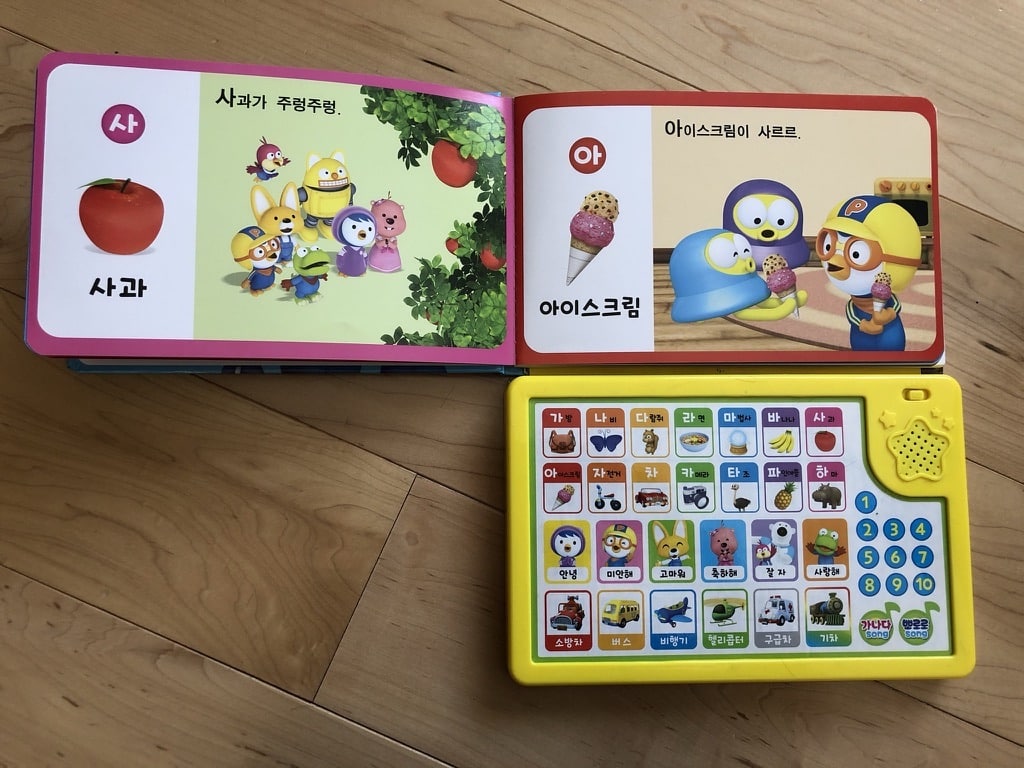
The second best thing about this book is that it features Pororo – a well known Korean cartoon penguin beloved by children – and his animal friends. You may have seen his face in your local Korean grocery store, plastered on everything ranging from crackers to chopsticks. Although somewhat less known in the U.S., Pororo enjoys a broad fan base both in and outside Korea.
Case in point – he has his own YouTube channel in 7 languages (including English, Spanish, and Russian) with more than 7M subscribers. So if you have a child under the age of 6, having Pororo featured in this book will probably make it twice as appealing as it otherwise would be.
One thing to note about this book is that there isn’t really anything to actively “read”. It’s designed in a way that allows kids to explore it on their own, through the sound buttons and simple illustrations. So, this book is very kid-friendly and serves its purpose well – to expose children to the Korean alphabet and basic vocabulary. And the fact that it does so without requiring any effort on my part… bonus!
12. 사랑해, 사랑해, 사랑해 (I LOVE YOU, I LOVE YOU, I LOVE YOU) by Bernadette Rossetti-Shustak, illustrated by Caroline Jayne Church, translated by Hyeong-geon Shin
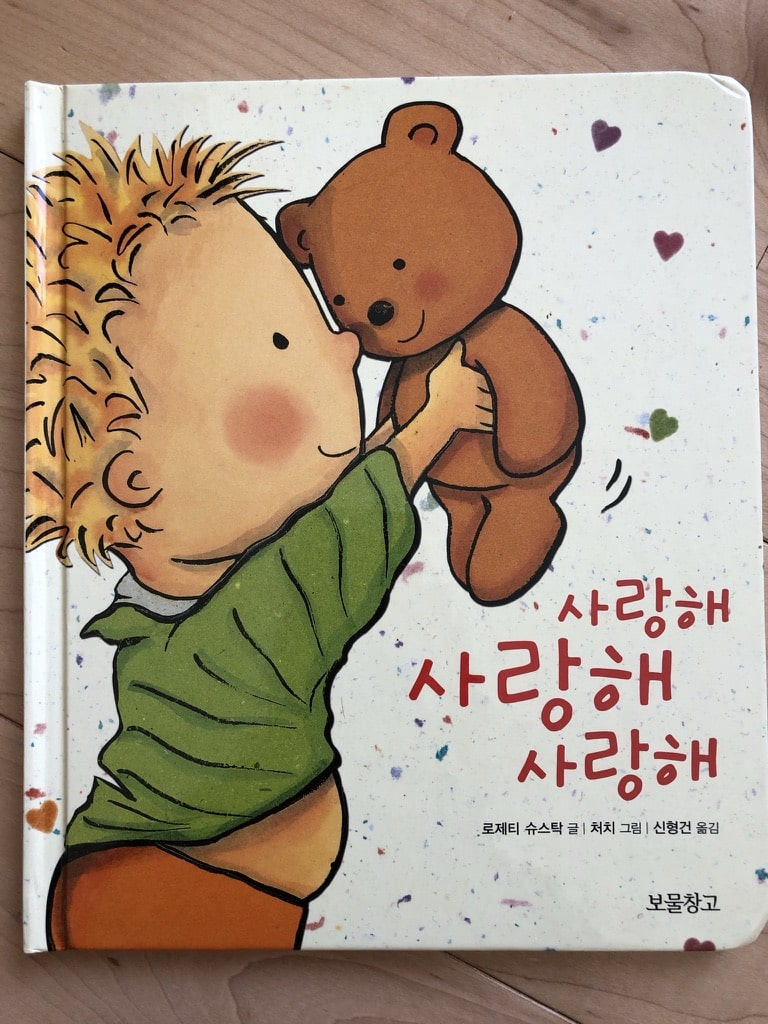
사랑해, 사랑해, 사랑해 is a Korean-translated version of the book, I Love You Through and Through – one of my favorite books to read to my kids when they were babies to young toddlers. In fact, I loved it so much that I felt compelled to buy the Korean translation when I stumbled across it while searching for Korean-language books on the internet.
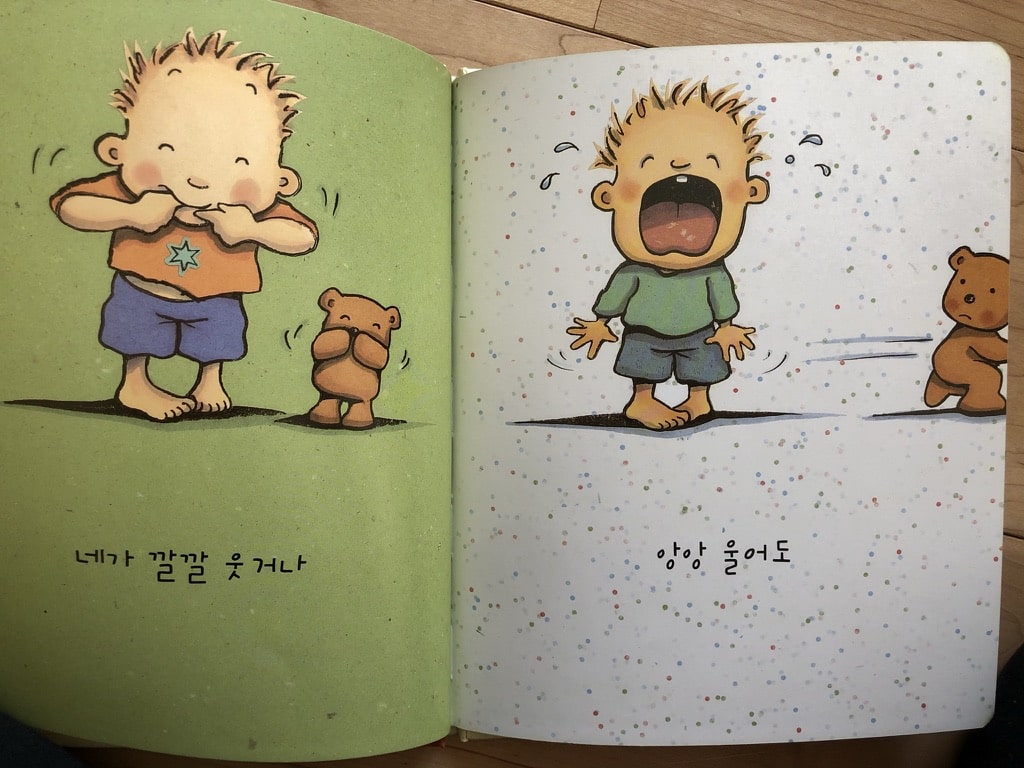
The book is told from the perspective of a parent speaking to their child, recounting all the different ways they love their little one. In doing so, it also introduces the concept of opposites, which is also clearly conveyed through clear illustrations of an adorable little boy and his inseparable teddy bear.
The story is simple and sweet, and the original English version of the book is told in rhyme. Unfortunately, the rhyme doesn’t carry over in translation, so the Korean version isn’t quite as catchy. Nevertheless, I still think it’s a great book overall – particularly if you’re looking for a short, Korean language book that you can easily read to your little one.
13. 아낌없이 주는 나무 (THE GIVING TREE, Korean edition) by Shel Silverstein, Korean edition published by Sigong Junior/Tsai Fong Books
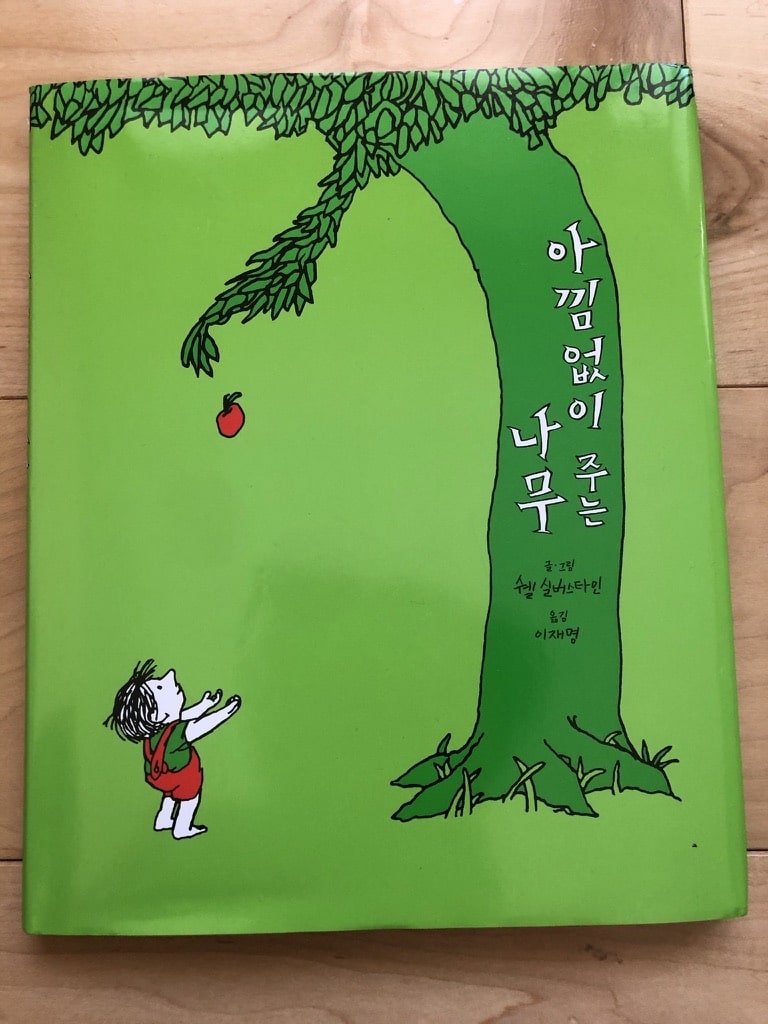
I love the original version of The Giving Tree. It was first published in 1964 and has since become a children’s classic – and for good reason, in my view. It chronicles the evolving relationship between a tree and a boy over the span of his life, from a young child to an elderly man. As you might surmise from the title, the tree selflessly provides to the boy throughout his life.
Apparently the book has sparked some controversy in more recent years, as it’s been interpreted to view the relationship between the tree and the boy as abusive or exploitative. But I still see the story as a beautiful, even if bittersweet, depiction of unconditional love as well as a sharp commentary on humankind’s selfish consumption of the environment.
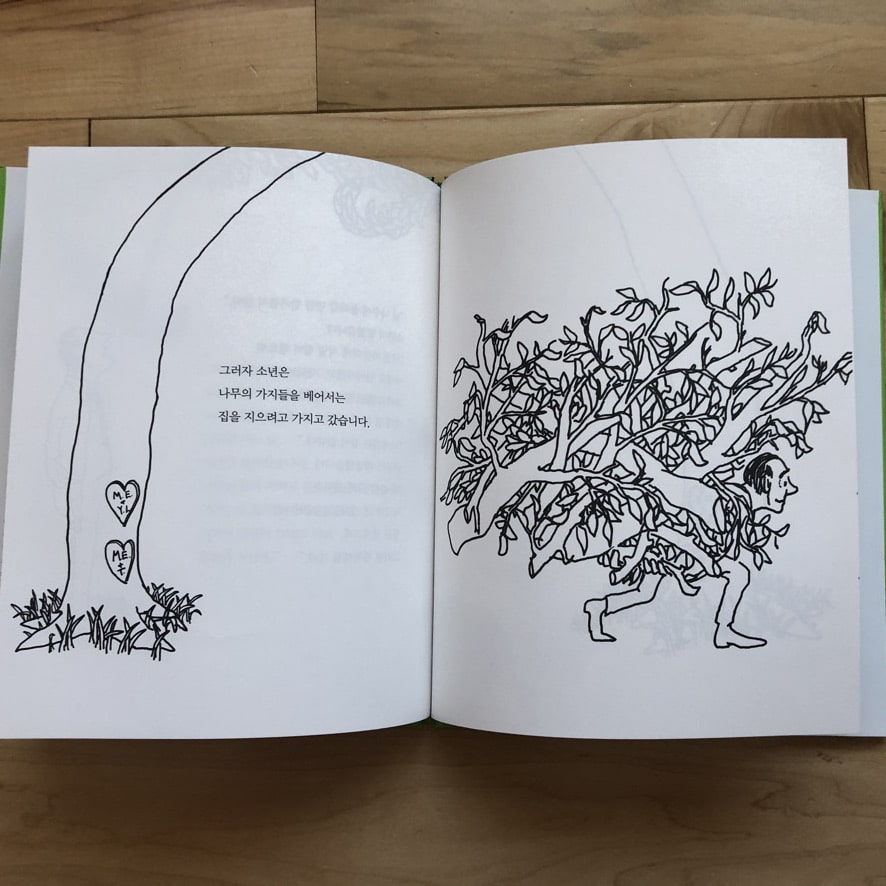
We own the original English version of this book and I wanted to have the Korean edition for my children. But as much as I love the book, my plan to use it to help my young kids learn Korean was a total fail. Between the lengthy foreign text and the minimalist sketches per page, the book couldn’t quite maintain my kids’ attention long enough to finish it.
Maybe they’ll get to a level of Korean proficiency someday when they can understand and sit through the whole book. Maybe not. But either way, in the meantime, it’s great Korean reading practice for me!
14. BEAUTIFUL SHORT STORIES IN ENGLISH AND KOREAN by Hye-min Choi
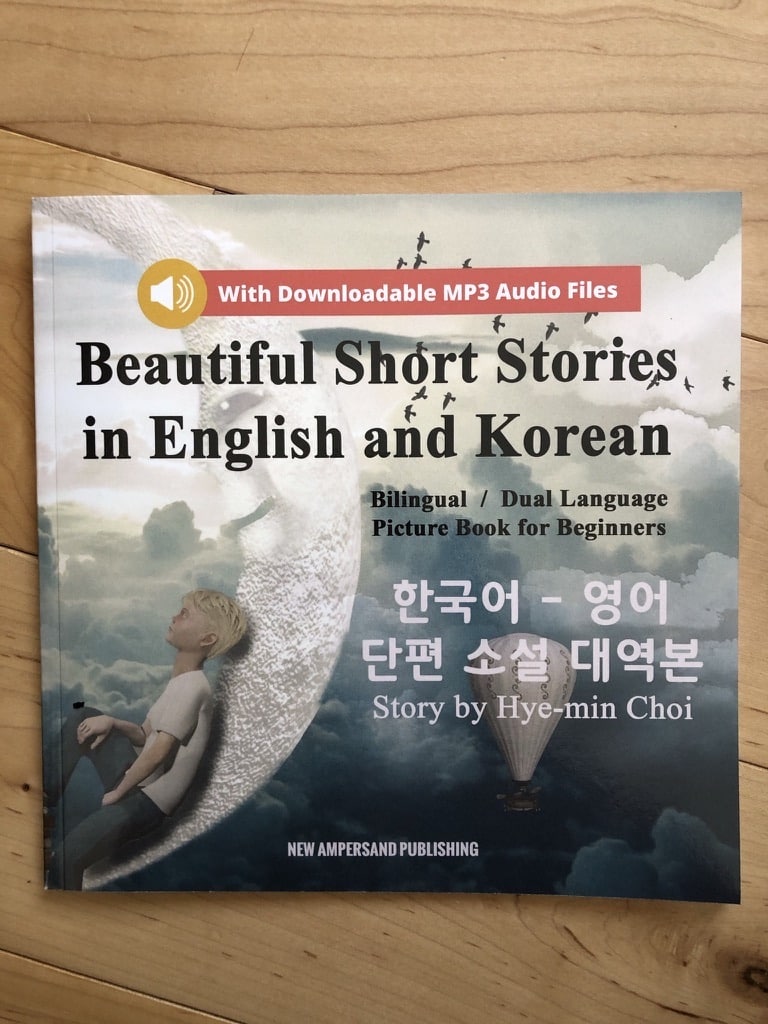
Beautiful Short Stories in English and Korean consists of 11 short stories written in Korean and English. The “stories” at the beginning of the book are very simple and read more like descriptive paragraphs than true tales. But towards the end of the book they become progressively longer and more story-like, often with canny endings or morals. The book also comes with downloadable audio files – which is particularly useful if you understand but can’t read Korean.
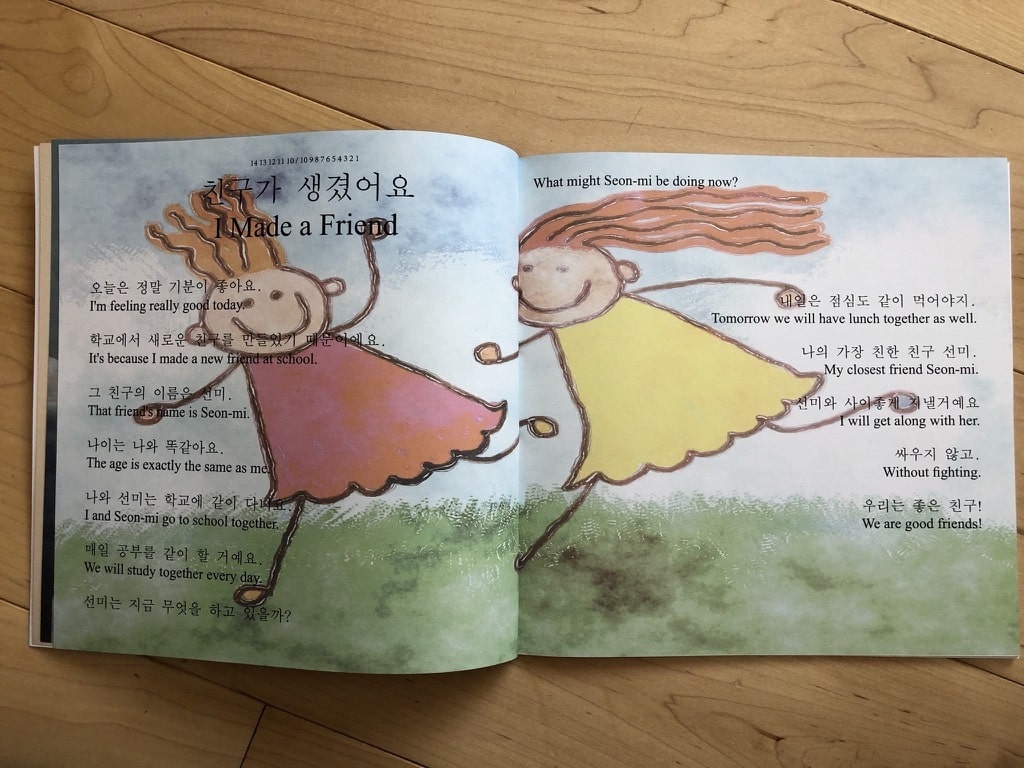
I bought this book in hopes of deepening my kids’ familiarity with the Korean language through fun and engaging stories. But I found this book to be geared more towards serious Korean learners than towards young children. It feels more like a series of immersion lessons than a collection of short stories.
And while a picture accompanies each story, the pictures are generally ancillary depictions of broad concepts that in many instances don’t add much to the book. Again, all appropriate for a student of the Korean language but less than ideal for bedside reading to little kids.
I plan to tuck this one away for the day my kids are older and (hopefully) have a better grounding in Korean. It’ll make a great study aid at that point.
15. MY FIRST BILINGUAL BOOK SERIES (Korean-English) by Millet Publishing
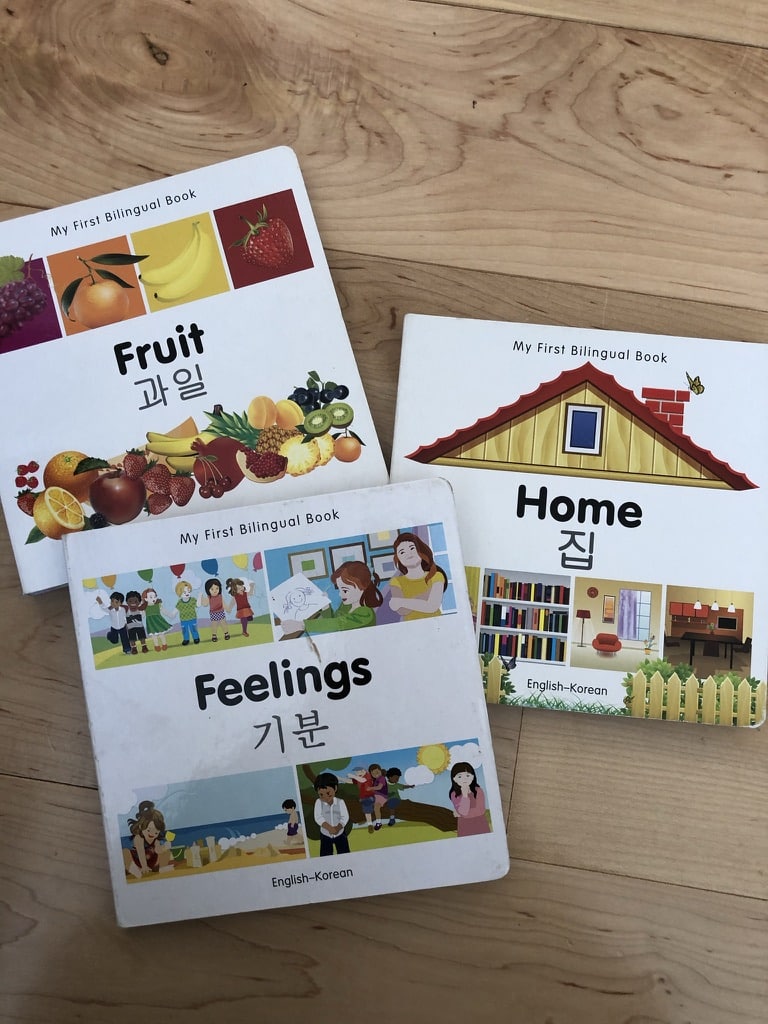
This is a series of bilingual books geared towards small children and beginning language learners that explores basic concepts such as feelings and opposites. The books are available in a wide range of languages, including Korean-English.
I bought a few of these in my search for bilingual books that would help my children learn Korean. But I find them marginally helpful in that regard. While some include full sentences and phrases, most are akin to a bilingual picture dictionary that simply labels objects in each language. While some might find those useful, I personally prefer (as do my kids) books with complete sentences that read like stories. I was also disappointed to find that one of the books contained a translation error (misusing the Korean words for younger/older sister).
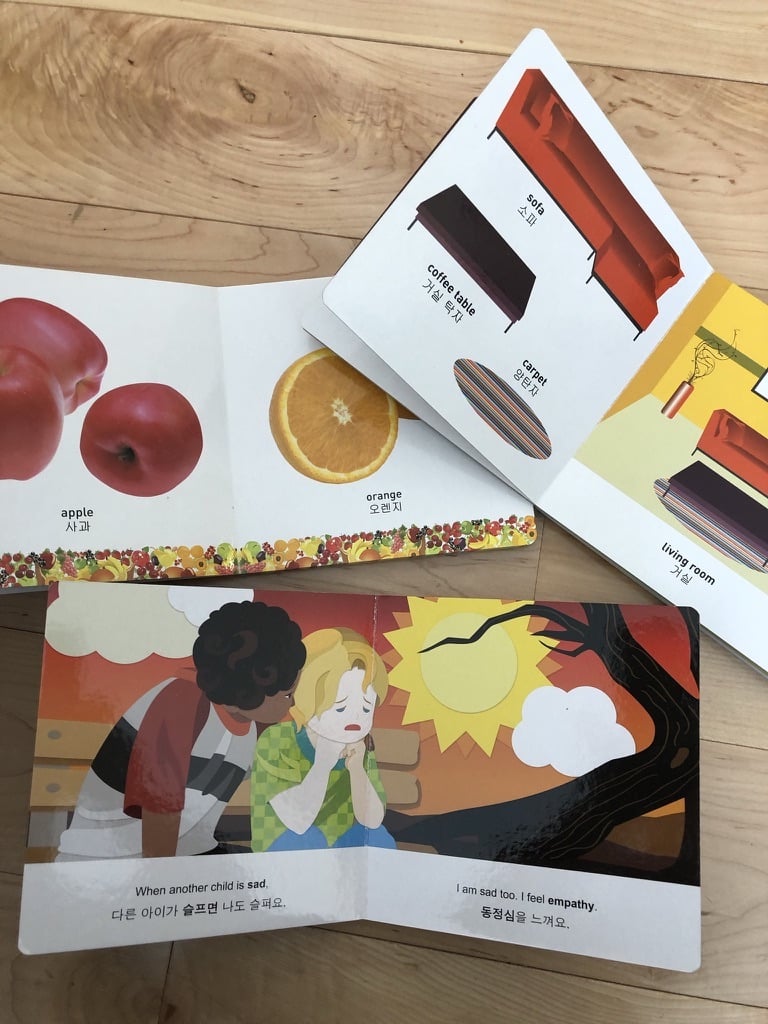
Aside from the educational aspect of these books, the pictures themselves aren’t particularly interesting or engaging. So it’s no surprise to me that my 5-year old had no interest in these Korean children’s books when he was younger, and still doesn’t today. Every now and then my toddler asks to read the book about feelings (which has complete sentences), but unfortunately, I don’t get as much use out of these books as I had hoped to.





